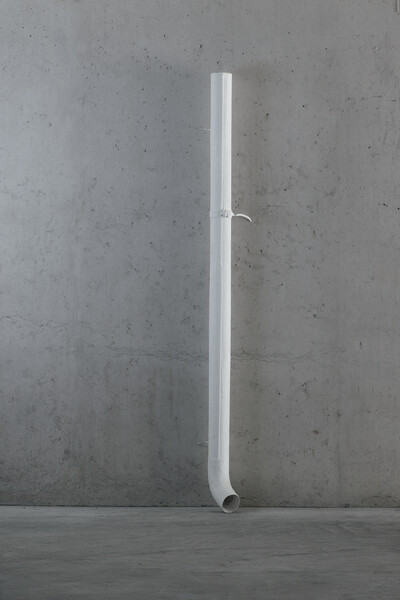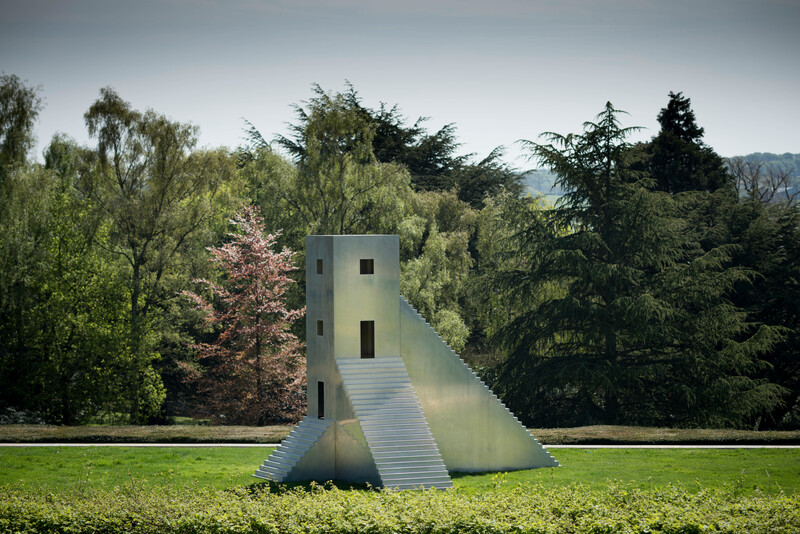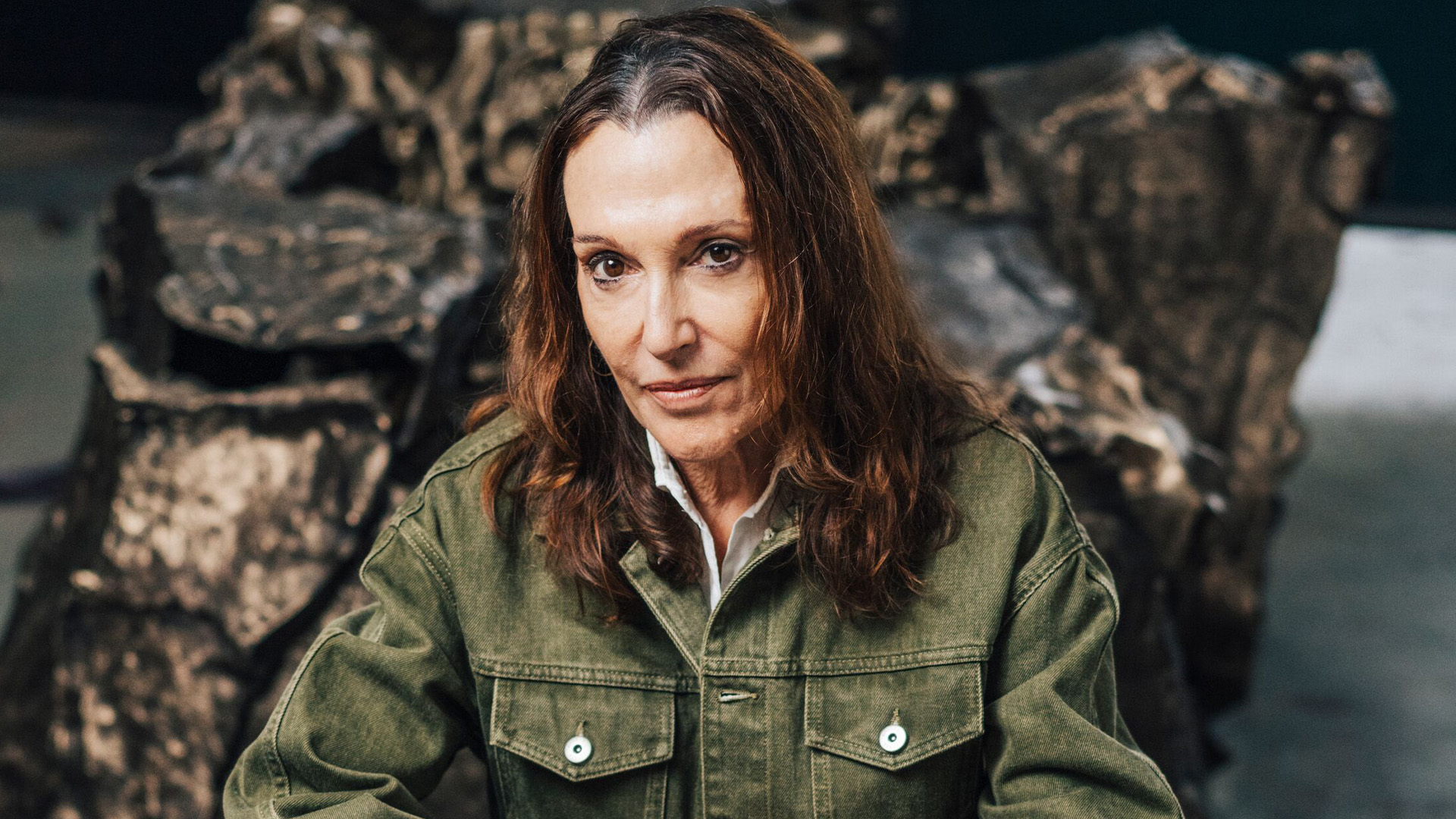Teachers’ Notes: ‘NOT VITAL. SCARCH’

(Left) Not Vital, 100 Architects, 2016. (Right) Not Vital, Chasa I Bogn, 1970 © Not Vital
Teachers’ Notes: ‘NOT VITAL. SCARCH’
This resource has been produced to accompany the exhibition, ‘Not Vital. SCARCH’ ’ at Hauser & Wirth Somerset from 28 September 2019 until 5 January 2020.
Not Vital was born in 1948 in the Swiss village of Sent in the mountainous region of Engadine, which borders Austria and Italy. Vital’s practice, which encompasses drawing, painting, sculpture and built structures, reflects his quasi-nomadic lifestyle. A number of Vital’s architectural installations and social experiments can be found within his sculpture park at Sent. Parkin Sent is open to the public throughout the summer months when the mountain and forest landscape is most accessible. Vital was granted permission to purchase and preserve the monumental 11th century Tarasp Castle near the town of Scuol, and since 2016, has reimagined a modern infrastructure within the historic building, creating a dreamscape of unexpected sculptures and collected objects from his enigmatic career to date, alongside other artists’ work.
Vital’s first language is the Latin-derived Romansch which is the rarest of Switzerland’s four official languages. Vital has had a long interest in preserving the Engadine region’s unique cultural assests and landmarks, establishing his own foundation in 2003 and developing one of the most significant libraries of Romansch literature in the world housed at Plantahaus in Ardez. Tarasp Castle, Parkin Sent and Plantahaus are open to the public as part of the Not Vital Foundation. Vital’s first major solo exhibition in the UK was held at Yorkshire Sculpture Park in 2016. He currently lives and works in Rio de Janeiro, Bejing, and Sent.
What does Not Vital’s work look like?
‘SCARCH’ is a multidisciplinary exhibition organised with Olivier Renaud-Clément and Giorgia von Albertini and includes early rudimental pieces from the 1960s, portrait sculptures, mixed-media works on paper and socially-driven installations relating to his global projects. Not Vital often combines art with architecture to create immersive, site-specific structures that provide a sense of wonder by means of alternative perspectives. As visitors enter the Threshing Barn they will encounter ‘House to Watch the Sunset’ (2005), a model from the ongoing international series currently in-situ in Agadez (Niger), Paraná do Mamori (Brazil), and Tarasp (Switzerland).
Crucial to these structures are not the comforts of home or the way in which we might live in them, but rather the way in which they enable us to look at the world. The original buildings, over thirteen meters high, have three stories, each unconnected and separately accessed via an outdoor staircase. Shortly after finishing the first structure of its kind in 2005 in Niger, Vital declared that ‘House to Watch the Sunset’ would become a global project: a structure would be built for the sole purpose of contemplating the sunset in every continent. While the materials of the building would always be site-specific, the form and dimensions would be the same at each location. Vital’s anthropological curiosity is further reinforced in ‘100 Architects’ (2016), where the artist presents an installation comprised of 101 black granite sculptures.
These sculptures are numerical portraits: the volume and size of each individual structure is determined by the date and year of each architects’ birth. The installation, which is presented in the Workshop gallery, represents and honours cultural figures who have made substantial contributions to the field of architecture. As visitors enter the Pigsty Gallery they will encounter Vital’s first sculptural work ‘Chanala da tet’ (1964), consisting of a roof gutter that he found on the street in front of his parents’ house that he painted white. This seminal work is on display alongside ‘Chasa i bogn’ (1970), a two-part work consisting of the simplified shape of a house and a children’s bathtub. The exhibition includes three outdoor ‘SCARCH’ installations; ‘Cannot Enter Cannot Exit’ (2020), installed in the farmyard looking out towards Bruton’s Dovecote.
The tower itself is the same height as Michelangelo’s David at just over five meters. Scattered across the front lawn and trapped within the tower are a series of stainless steel hay bales covered in white varnish. ‘Bale’ (2018) represents the agricultural cycle and winter season. ‘Date’ (2016) situated in the Cloister Courtyard, is a three meter tall, fruit-shaped sculpture enveloping the viewer in an inverted world. The stainless steel structure stands in stark contrast to the organic forms surrounding it.
Does drawing form part of Not Vital’s practice?
In the Pigsty gallery are a series of three-dimensional works on paper, created as performative experiments running in parallel to Vital’s large-scale sculpture making. Vital often draws while travelling, collecting additional materials from pharmacies and hardware shops, producing work that consists of whatever is available to him: tape, cotton swabs, silicone patches, and plastic bags.

Not Vital, Chanala Da Tet, 1964 © Not Vital

Not Vital, House to Watch the Sunset, 2005 © Not Vital
What are the main themes of Not Vital’s work?
Architecture
Not Vital has a deep-rooted interest in the relationship between architecture, landscape and human perception. The first hut or home he built was as a child during his summer vacation whilst living in Sent. Vital now creates structures and homes which are both architecture and sculpture. In order to give a name to these more recent large-scale structures that bridge sculpture and architecture, Vital coined the term ‘SCARCH’ in 2009.
Community
Many of Vital’s projects and artworks involve a communal experience of people interacting with the sculptures or being involved in their making. In 2004, he created ‘Makaranta’ in Agadez, Niger. This is a pyramid structure, on top of a hill, upon which children can sit, play and learn. Built in one of the poorest countries in the world, the pyramid has become a school and playground for 600 children, and when full is transformed into a mountain of children. Identity ‘100 Architects’ (2016), presents one hundred and one black granite sculptures that are numerical portraits of architects. The volume and size of each individual structure is determined by the date and year of each architect’s birth.
Material
Vital works with plaster, stainless steel, marble as well as paint and organic materials. Vital’s choice of material is connected with his experience of the world. His choice of ‘white’ materials relate to his experience of snow and landscape; for six months of every year the landscape of his childhood was covered in white. Vital enjoys the physicality of playing and working with different materials.
Travel & Exploration
Vital is an adventurer-artist exploring the world, becoming part of the places and people he meets, living between the United States, Niger, Italy and China, as well as his native Switzerland. He has created a series of site-specific projects, some in remote areas, around the world that can be visited.
How does Not Vital make his work?
Vital has travelled widely and is able to immerse himself in new contexts and cultures with ease, collaborating with local craftspeople and sourcing regional production in the most remote areas. He has worked with steel chasers in Beijing and glass blowers in Murano, silversmiths in Agadez and papermakers in Bhutan.
What other artists’ work does Not Vital’s practice relate to?
Joseph Beuys
Beuys was a German Fluxus, happening, and performance artist as well as a painter, sculptor, medallist, installation artist, graphic artist, art theorist, and pedagogue. His extensive work is grounded in concepts of humanism, social philosophy and anthroposophy. He is widely regarded as one of the most influential artists of the second half of the 20th century.
Daniel Buren
Buren is known best for using regular, contrasting colored stripes in an effort to integrate visual surface and architectural space, notably on historical, landmark architecture.
Martin Creed
‘Creed is a social artist; the true magic of his work lies in the way it interacts with people and places’. (Jonathan Jones, ‘Martin Creed’s stairway to heaven’, in: www.theguardian.co.uk, London/UK, 1 August 2011)
Dan Graham
Graham’s multi-disciplinary practice – which incorporates installation, pavilions, sculpture, photography, conceptual projects, architectural models, video and performance – has proven groundbreaking for the development of conceptual art over the last 40 years.
Richard Long
Long’s work has broadened the idea of sculpture to be apart of performance art and conceptual art. His work typically is made of earth, rock, mud, stone and other nature based materials. In exhibitions his work is typically displayed with the materials or though documentary photographs of his performances and experiences.
Mark Wallinger
Wallinger is known for his career-long engagement with ideas of power, authority, artifice and illusion.
Smiljan Radić
Radić is the Chilean architect who designed the 2014 Serpentine Pavilion which now sits at the far end of the Oudolf Field.

Not Vital, 100 Architects, 2016 © Not Vital
GLOSSARY ARCHITECTURE
The art or practice of designing and constructing buildings.
COMMUNITY
A group of people living in the same place or having a particular characteristic in common.
COMMUNITY ART
Community art is artistic activity that is based in a community setting, characterised by interaction or dialogue with the community and often involving a professional artist collaborating with people who may not otherwise engage in the arts.
CONCEPTUAL ART
Conceptual art is art for which the idea (or concept) behind the work is more important than the finished art object. It emerged as an art movement in the 1960s and the term usually refers to art made from the mid-1960s to the mid-1970s.
INSTALLATION
Mixed-media constructions or assemblages usually designed for a specific place and for a temporary period of time.
MATERIALITY
A focus on the physical qualities or state of the material as integral to the art.
MONUMENT
A structure created to commemorate a person or event. Monument often refers to a building or structure of historical or cultural significance.
SCULPTURE
Three-dimensional art made by one of four basic processes: carving, modelling, casting and constructing.
SITE-SPECIFIC
Refers to a work of art designed specifically for a particular location and that has an interrelationship with the location.
READYMADE
The term readymade was first used by French artist Marcel Duchamp to describe the works of art he made from manufactured objects. It has since often been applied more generally to artworks by other artists made in this way.
Suggested activities during your visit:
IDENTITY
What is a portrait?
How do you think ‘100 Architects’ has been made?
Write down your date of birth. Use these numbers as dimensions to draw a shape.
ARCHITECTURE
How is this building different to other buildings? What could we use it for?
Use a compass to find out where the sun would set and where it would rise. Imagine the sun setting as if seen from the Radić Pavilion. What would it be like?
In the Oudolf Field, find a place where you can sit on the grass and watch the clouds. Close your eyes and listen to the sounds, feel the breeze on your skin. Try and be silent for a few minutes. Pay attention to the sensations around you. Imagine how the Oudolf Field changes from morning to dusk to night time.
Draw any shape on a piece of paper. Transform your shape so it looks three-dimensional, i.e. by shading or adding perspective to your shape. How could your 3D shape become a building? Add details, draw people or an environment around it to give a sense of scale? What could your building be?
COMMUNITY
What do you understand by ‘community’?
Can you draw a community? It could be an image of a community, or even a community drawing.
Practical activity prompts and ideas for discussion following your visit:
Find out the birthdays of your family and friends. What would their birthday shapes be? Use rulers and scale to draw your birthday shapes. What happens if you add all your shapes together? Using paper or card transform your designs into 3D Find different man-made materials: gaffa tape, silver foil, card, paper, fabric, plastic, glass, string, elastic, rubber, balloons. What can you do to transform the materials so they have different qualities? Try smoothing, wetting, scrunching, pulling apart, tearing. Make observational drawings, take photographs, make films of what happens. Draw with water – dribble, splatter, pour and throw. Use different instruments such as watering cans, bottles and brushes. Take a photograph of your drawing before it disappears.
Related artists: Arshile Gorky Anthony Caro Eduardo Chillida Julio Gonzalez Monika Sosnowska Henry Moore

Not Vital, Synagogue for Tel Aviv, 2009 © Not Vital

Not Vital, Night House, 2019 © Not Vital
Supplementary Research
Not Vital website Not Vital Foundation ‘Not Vital. SCARCH’
Published by Hauser & Wirth Publishers, edited by Olivier Renaud-Clément and Giorgia von Albertini.
Inside the Many Houses of Not Vital, Maker of Dreamscapes for Adults
Andrew O’Hagan, New York Times Style Magazine, Oct. 18, 2013 Not Vital at Yorkshire Sculpture Park, 2016
Resources
1 / 10









